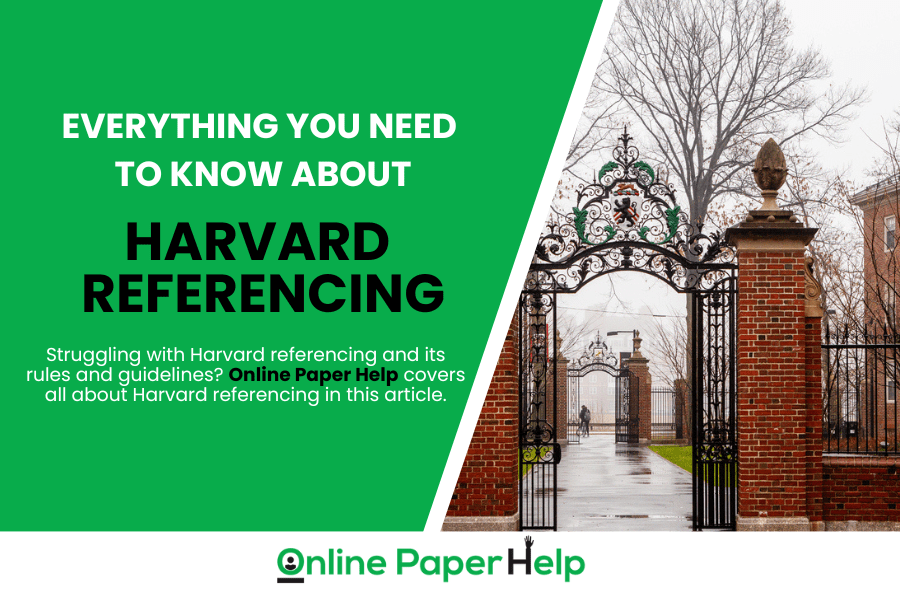Everything You Need to Know About Harvard Referencing
Everything You Need to Know About Harvard Referencing
Various referencing styles are used in academia, including the American Psychological Association (APA), Modern Language Association (MLA), Chicago, and Harvard. Harvard referencing is one of the most popular citation styles. It emphasizes the importance of consistency and accuracy. Developed by Harvard University, this referencing system gained popularity for its simplicity and popularity. It provides a standardized and easily recognizable format for citing a wide range of sources, including books, articles, websites, and other materials used in academic writing and even general essay writing.
Using Harvard referencing in academic writing is important because it provides integrity and effective communication. It also provides a transparent and standardized method for creating the ideas, research, and contributions of others.
In this comprehensive guide, we will explore the key elements of Harvard referencing, the advantages of the Harvard Referencing guide, and discuss the rules of Harvard referencing.
What is Harvard Referencing?
Harvard referencing is a citation style that was originally introduced by Harvard University. Whether you are a student, researcher, or writer, you can use Harvard citations to maintain academic integrity. This system promotes transparency, acknowledges original authors, and helps readers familiarize themselves with the original source of content. This transparency enhances the trustworthiness and academic excellence of the work. Understanding and correctly implementing Harvard referencing is important to produce well-documented research papers and essays. Harvard referencing may have minor variations, like style and formatting, based on guidelines provided by the institution, journal, or publisher.
1. Advantages Of Harvard Referencing
Clarity and Consistency
Harvard referencing provides a consistent and precise way to cite. It allows readers to locate and verify references used in a document. When you use Harvard citation, it shows where you got your information. Harvard referencing allows for consistency. Since each source it cited in the same fashion, your work looks neat and organized.
Credibility
Credibility is established through proper citation and referencing of sources. When you cite your sources using the Harvard style, readers are able to find the origin of information and ideas presented in the paper. Thus, Harvard referencing adds more credibility to your academic paper or any type of essay writing.
In-Text Citation
In Harvard Citation, an in-text citation is an essential component. It helps acknowledge the sources of information, ideas, and evidence used within the text. The most important part of in-text citation is providing the author’s name and the year of publication in parenthesis within the body of the text. It allows readers to locate the corresponding entry in the bibliography easily.
Comprehensive Information
The author’s name and publication year are provided within the text in Harvard citation. Harvard referencing includes a detailed reference list. This offers a concise yet comprehensive way of attributing information to its original source. Furthermore, Harvard citation includes a detailed reference list at the end of the document. It presents all the sources used in the text in a consistent and organized manner.
Avoiding Plagiarism
One of the benefits of Harvard citation is that readers will get plagiarism-free content. It encourages writers to rephrase, quote, and cite appropriately, which is essential in essay writing. Also, it shows that you respect the ideas and work of others. This system also provides the opportunity for readers to check the original sources, as it adds trustworthiness to your work. Furthermore, it enhances the clarity of the provided information.
2. Rules Of Harvard Referencing
While following Harvard referencing, you must follow the specific rules to refer to sources in academic writing. The following are the key rules:
Paraphrasing
While paraphrasing someone else’s work, remember that you still need to cite the sources. Use the author’s and publication year as in-text citations.
Reference List
At the end of your work, you must provide a detailed reference list that includes all the sources. This list must be alphabetically arranged by the author’s last name. You must ensure that your referencing list consists of the author’s name, publication year, title of work, publisher (for books), and other specific details.
Italics
You must use Italic font for the title of your book and the names of journals, newspapers, and other publications.
URLs
As web content may change over time, when referencing online sources, the writer must include the URL and the date the site was accessed.
No Authors
If there is no author mentioned, then you must refer to the title of the work or the name of an organization in place of the author. Using this substitute method helps ensure that proper knowledge is provided while acknowledging the absence of the author.
Secondary Sources
If you are referencing a source that you found within another source, you must mention both sources in your texts. When it comes to listing, only provide the source you actually consulted in your reference list. The use of secondary sources in research provides valuable contexts and insights.
Multiple Authors
If your source consists of multiple authors, then put at least list three names in your citation. Remember to mention the first seven authors while listing. This acknowledges all the authors while maintaining clarity and conciseness.
In-Text Citation
While using Harvard referencing, in-text citations are essential for giving credit to the sources used in writing. When you mention sources, put the author’s last name and the publication in parentheses. Writer can also add page numbers in their citation.
Quotations
Quoting directly from a source, writers must enclose the quoted text in double quotation marks. It is followed by an in-text citation that includes the author’s name, publication date, and page number, if applicable.
3. Harvard Referencing Examples
Here are some examples of how to use Harvard referencing in books, journals, and websites.
Harvard Referencing a Book
Author(s): Last name, First initial. (Year of publication). Title of the book. Edition (if not the first edition). Place of publication: Publisher.
For example, if you were referencing a printed book with the following details:
Author: John, Smith
Year of Publication: 2012
Title: “The Art of Harvard Referencing”
Edition: 2nd edition
Place of Publication: New York
Publisher: Academic Press
The Harvard reference citation for this book would be:
John, S. (2012). The Art of Harvard Referencing (2nd ed). New York: Academic Press.
Harvard Referencing a Journal Article
Author(s): Smith, J. A.
Year of publication: 2019
Title of the article: “The Impact of Climate Change on Biodiversity”
Title of the journal: Environmental Science Quarterly
Volume number: 42
Issue number: 3
Page range: 345-362
In-text citation: (Smith, 2019)
Reference list entry:
Smith, J. A. (2019). The Impact of Climate Change on Biodiversity. Environmental Science Quarterly, 42(3), 345-362.
Harvard Referencing a Website
Author(s) Last Name, First Initial. (Year of publication). Title of the webpage. Website Name. Available at: URL (Accessed: Date).
For example:
Smith, J. (2022). The Importance of Sustainable Farming Practices. EcoFarming Network. Available at: the website link (Accessed: October 20, 2023).
4. Common Mistakes Students Make In Harvard Referencing
Incomplete In-Text Citations
One of the major mistakes in Harvard referencing is not adding proper details in in-text citations. Incomplete citations, where details are lacking, can create confusion for readers, especially in essay writing where clarity is key. They might have doubts about the information, and it makes them question the credibility of the source.
Missing Page Numbers for Direct Quotes
Referencing page numbers makes it easy for readers to check and understand what the writer is talking about. Sometimes, writers forget to add page numbers. This may create problems because it will become harder for readers to find the exact source. You can easily avoid these mistakes when you consider expert assistance.
Errors in the Reference List
Errors include missing and wrong information, not giving complete names of authors, wrong publication dates, and not providing source titles properly. Additionally, if the list is not appropriately organized in alphabetical order, then it will be tough for readers to find the sources. These mistakes can make your work look unprofessional. Therefore, attention to detail in the Harvard referencing guidelines is essential to avoid such errors.
Incorrect Order in The Reference List
The referencing in Harvard citation means providing readers with a systematic and organized way to locate and verify the sources. When these sources are listed improperly, it can lead to confusion. This disorganization may also raise questions about the credibility and diligence in conducting research and citing sources.
Formatting Issues
When writers use Harvard referencing, they might make formatting mistakes. One of the most common issues is where to put the author’s name, the publishing year, and page number if needed. It is essential to put book titles in italics, use correct punctuation, and organize the list.
Misquoting
Misquoting can lead you to face severe consequences for academic integrity and credibility. This involves inaccurately representing words or ideas of a source. It will lead to distortion of the author’s intended meaning. This will ruin the trustworthiness of the writers and the entire document.
Citing Lecture Notes and Personal Communication
Using incorrect citations and information can lead to misunderstanding and academic misconduct. With inaccurate cited lecture notes, you risk misrepresenting the information’s source. Similarly, neglecting to acknowledge personal communications can result in a lack of transparency.
Wrong Date Format
Accurate and consistent citation of publication dates is important as it allows readers to trace and verify the resources. Employing the incorrect date format, such as mixing American and British styles or failing to include the publication date altogether, can mislead the audience.
Not Adhering To Specific Institutional Guidelines
Institutional guidelines are designed to ensure consistency and quality in citations. Violating guidelines can lead writers to face severe consequences, accusations of plagiarism, and a lack of credibility in the work. It will show that your work does not fulfil the academic standards of the institution.
FAQs
1. Can Harvard reference use footnotes?
Harvard referencing does not use footnotes for citations. It typically relies upon in-text citations that involve the author’s name and the publication date within the text and body. However, there are some specific preferences from academic institutions or for particular assignments where footnotes are allowed.
2. Who uses Harvard referencing?
It is mainly used in educational areas. Students at different education levels, from high school to postgraduate, use Harvard referencing. They are often introduced to this citation as a fundamental part of academic writing and training.
3. How should Harvard referencing be listed?
The list should be arranged alphabetically at the end of the academic or research paper. Writers should include the author’s last name or the first word in the source title. They must ensure that each entry in the list provides the correct information about the source, including the author’s name, publication date, title of the publication, and URLs. It not only gives credit but also provides transparency and originality in writing and research.
4. Why is Harvard referencing important?
It is actually the most important part of writing as it shows transparency and credibility and standardizes the methods for acknowledging resources. It also prevents plagiarism, which is when you use another’s work without referencing it. Harvard referencing allows you to respect other people’s content. Also, it helps readers to check sources and find more information.
5. Are there any disadvantages of Harvard referencing?
While there are advantages to Harvard referencing, there are also some downsides. It can be relatively time-consuming, as it requires attention to detail in formatting and citing the sources. Another disadvantage is that Harvard referencing relies heavily on in-text citations, which leads to disruption of the content.
6. Is Harvard Referencing used for essay writing outside of academics?
A: Yes! While Harvard Referencing is primarily used in academic settings, the principles of accurate citation and avoiding plagiarism are fundamental to any type of essay writing. Whether you’re writing a school essay, a persuasive essay, or a blog post, understanding how to properly reference sources enhances the credibility and trustworthiness of your work.
Conclusion
Harvard referencing is widely used in academic writing. It may promote clarity, credibility, and accessibility. However, everything comes with disadvantages and challenges. Time-consuming formatting and variations are some of the disadvantages of Harvard referencing. Nevertheless, it is a valuable skill that enhances the quality of academic writing. Understanding and using this citation is a valuable asset for any researcher or writer.
Online Paper Help assists individuals in creating properly formatted citations and references. If you have an academic paper or assignment that requires Harvard referencing, we can assist you in completing it. Our experts are well-versed in all citation styles, including Harvard. So, contact us now and let us help you elevate the quality of your academic work while maintaining proper citations and references.












